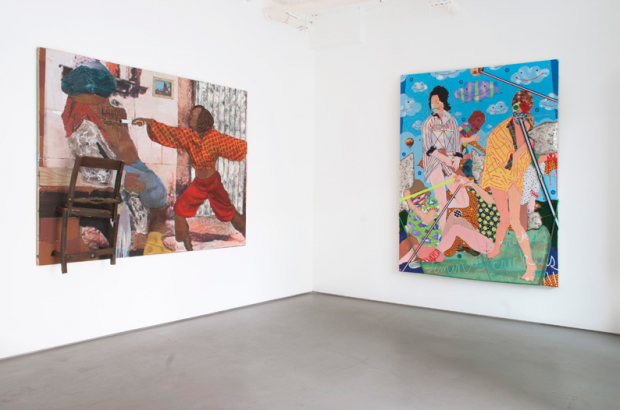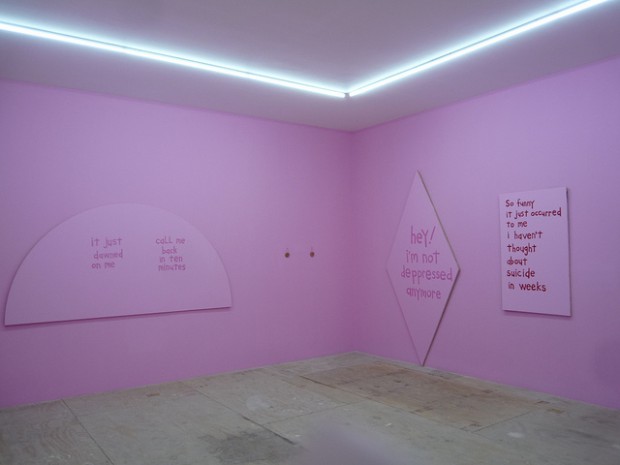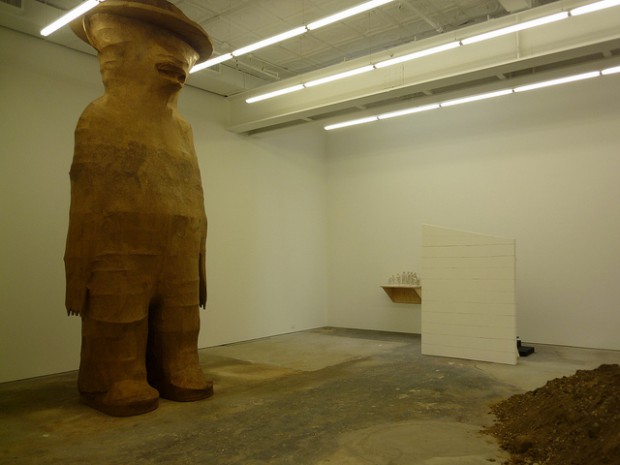Thierry Goldberg
103 Norfolk Street
Aaron Fowler & Michael Shultis
September 8 – October 6, 2013
What’s on view: Mural-sized paintings and collages of pirates and women in spandex. Collages look like big ships, including toilet papers, ironing boards, bags of socks, and various household items.
Whitney: This collaborative series by Aaron Fowler and Michael Shultis looked like what might happen if you mixed Kara Walker with Nolan Hendrickson, and then ran them through a tornado of bannisters, stretcher bars, toilet paper, and laundry. The scenes and styles are very familiar; Fowler’s dueling pirates mimic Walker’s torn figures and rough charcoal drawings. Shultis’s spandexed women clearly nod at Hendrickson’s laser dance fights.
But for me, the meaning didn’t measure up to those artists. There’s a lot of dark humor underneath Walker’s and Hendrickson’s effortless mark-making, which feels very true to life. That same joy of skill was there in Fowler and Shultis, but stock pirates still feel like a convenient device to build ships.
Corinna: Though the content didn’t really matter much to me, like those silly, fantastical scenes of pirates—there’s an amazing plank sticking out of the canvas for the pirate painting—the show works. I kept on coming back to look, because of the sheer ridiculous effort that went into creating each canvas’ scene: cotton balls, vinyl (so much vinyl), craft store ribbon, and pretty much anything else you might find at a costume shop or Hobby Lobby.
Paddy: I don’t see too much Walker in here, and I’m happy about that. The subject of racism is important to address in art, so I feel a little bit guilty about saying this, but I’m tired of the cutouts.
Anyway, my first impression was similar to both of you, but I really don’t think that holds up under close inspection. The text in these paintings is sometimes really dark; “Nigga f**k Yu Cousin” takes the place of a pirate’s face. He’s in the midst of a stick up, and like a victim that can only remember the words of their attacker, that’s all a viewer is given. In another painting, the words “aaah shit” are printed over a guy getting stabbed in the chest. Not so dark, I guess, but about right for what’s just happened.
The press release talks about how the fictional dramas transgress into the real world, and that’s not just bullshit. The great thing about that plank in “Untitled” isn’t just that it sticks out of the canvas, but that the guy who’s about to walk it can see the footprints of the last victim forced off it. I also liked the black-and-white dirty sock bag, affixed to the canvas of “Gee Wiz.” In that picture, a laser beam comes out of a woman’s mouth, and actually knocks off a woman’s nose, bloodying it in the process.
So the lasers, the fluffly clouds, the bright colors all look pretty fun and fantastical, but it’s the darker elements of these paintings that really tether them to the real world.
Whitney: Yeah, you’re right, that was all there—this was just more entertaining IMO, like Quentin Tarantino rather than Spike Lee.
Invisible-Exports
89 Eldridge Street
Cary Leibowitz: Paintings and Belt Buckles
September 6 – October 13, 2013
What’s on view: A pink room with phrases on pink panels and silvery belt buckles
Whitney: There are two different voices in the text in this show, one for the panels and one for the belt buckles. On the belt buckles, Leibowitz has engraved trophy captions, which are meant to mimic the perspective of a child looking up at the adult world. (I read buckles like “The Greenwich, CT Ab-Ex’s Annual Nov 8-10, 1974” as mocking prizes for Connecticut art collectors.) The pink panels are inner monologues of anxiety, like “So funny it just occured to me I haven’t thought about suicide in weeks” and “Isn’t it great you like pizza I like pizza.”
Overall, I thought the phrases, all said something about conforming by taste, and like the uniform color, it’s both comforting and nauseating. If Leibowitz really wants to break the norm, then I think he does a pretty good job. It’s a weird show, and unlike most of what you find in the Lower East Side.
Paddy: Or conforming to lifestyle choices. In the 90’s Leibowitz was a leading figure in what’s been called “Pathetic Aesthetic” or “Loser Art”; Sean Landers-type stuff, but with greater abjection and self-hatred. As such, some of his work can easily be mistaken as being driven by an interest in kitsch, which is unfortunate, because at this point that exploration has proven to be dead-end.
For a text-based exhibition, I’m surprised to find myself writing that it needs to be viewed in person. All those metals about “Tippy Toe Tuesdays” and “Consciousness Raising in Raising” (not sure what state) look really large on the website, but are dwarfed in the show next to text like, “hey! I’m not depressed anymore” or “it just dawned on me.” It’s congratulatory messages for losers, and it’s more impactful when viewed together, in the space.
Speaking of the gallery, I’m not sure what’s going on with the light, but it feels like it’s been calibrated with the pink on the walls so the exhibition vibrates a little. It’s hard to spend any length of time in the show without feeling queazy. It’s a dark, internal optic I appreciate, but for the purpose of self-preservation, don’t want to spend any time with.
CANADA
333 Broome Street
Joanna Malinowska: A Hawk from a Handsaw
September 14 – October 20, 2013
What’s on view: A pile of dirt; a giant papier-mâché wood man who looks like he was carved with a chainsaw; a cartoon-style, rabbit-eared TV set playing a video monologue, spoken by a Russian man.
Whitney: The show seemed to ask Americans to imagine life without consumerism, and to look at Communism from the perspective of poverty. Even the earthy look of the show itself has simplicity and thoughtfulness that makes everything outside look like junk—just walking around the other galleries makes you notice the insane excess of materials in everything. In the back corner, facing the wall, an old man on the TV reads a letter to America: “Russia wants to take the cars out of our garages … America, this is the impression I get from reading newspapers.” He continues: “America, you don’t know what a good thing the party was in 1935.” It made me think of how totally foreign that experience is from growing up in the US in the nineties.
Then there’s the 20-foot-tall wooden worker man, titled “Falsely Humble.” I know this might be a stretch, but it reminded me of people’s reactions to Vladimir Putin urging Americans not to think of themselves as exceptional—people seemed to view it as either a welcome dose of humility or an imperialistic overreach, and it seems crazy that it could go either way.
Corinna: I appreciated the resourcefulness that went into this show: the cardboard TV, papier-mâché, a simple lean-to for a painting. Communist or no, it reminded me of the sheer excess we’re exposed to with art—like, really, why do we need so much of a spectacle, when we can achieve a similarly grand effect through limited means?
Paddy: I find it hard to think of a 14-foot plus papier-mâché sculpture as restrained, but I see what you mean. This isn’t the kind of exhibition you leave feeling overwhelmed by the gloss of contemporary art.
Speaking of that sculpture, I spent a lot of time thinking that guy was Yogi Bear. That’s obviously incorrect, but it’s worth noting nonetheless because the lens of American Culture never fully disappears for most viewers. That perspective, is also noted in the video itself in reference to how we perceive Russia, so that misperception seemed about right for the intentions of the piece.
Also worth noting: the TV is in corner facing the wall. That’s obviously intentional and reflective of our culture; if you want to learn about the Russian perspective (or any other), it gonna take some work. Other voices are never positioned so you can easily access them.
Corinna: Okay, a giant sculpture isn’t “limited means” in the sense of scale, but I just meant in terms of materials. That’s not bronze, for example, which points to what you nicely stated as “the gloss of contemporary art.” God, there’s so much shine in art today!





Comments on this entry are closed.